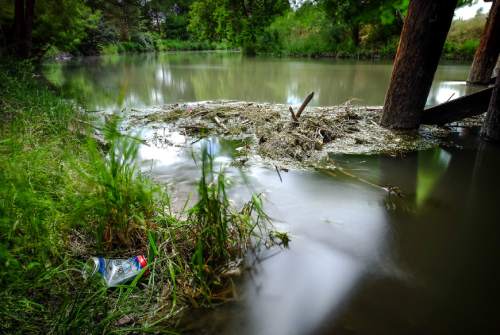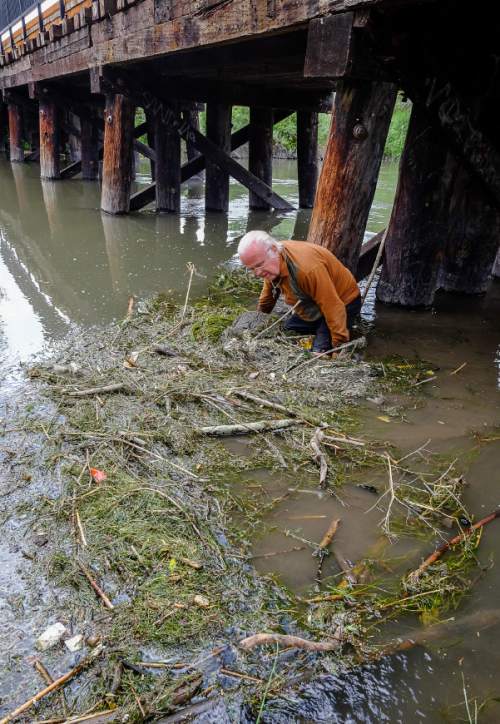This is an archived article that was published on sltrib.com in 2016, and information in the article may be outdated. It is provided only for personal research purposes and may not be reprinted.
A majority — 71 percent — of Utah's lakes fail to meet applicable water quality standards, and 43 percent of Utah's streams likewise failed, according to a new state report.
Compiled every other year by the state Division of Water Quality (DWQ), the report is intended to determine whether the condition of Utah's waters supports the uses assigned to them — uses such as providing drinking water, recreation or habitat for wildlife.
This year's report added new "impaired" designations to several Utah waterways, including two segments of the San Juan River, which exceeded water quality standards for concentrations of heavy metals. The metals were detected during monitoring operations associated with the Gold King Mine release last summer, and may or may not have been a direct result of that incident, said Walt Baker, director of the Utah DWQ.
The report also pointed to a developing issue that has historically been difficult to detect — blooms of algae capable of producing potentially fatal toxins.
Refined methodologies for assessing algal blooms led the state to list parts of Utah Lake as impaired due to unsafe concentrations of the microorganism that produce toxins, some of which can prove fatal if ingested.
While Utah Lake has been considered impaired for 12 years, Baker said addressing those concerns had been put on the back burner while other agencies addressed higher-priority issues on the lake. But the development of toxic algal blooms in the lake has captured the DWQ's attention, he said, and is its top priority.
Toxic algae isn't just affecting Utah Lake. Data discussed within the 2016 report suggest Farmington Bay should also be listed as impaired on account of toxic algae. Baker said the declaration likely won't become official until 2018 as study of the area continues. Last year, the DWQ determined that about 44 percent of Utah's waters, including some that provide drinking water, are at risk of developing toxic algal blooms.
"This has the potential to affect how we use our waters, whether we can even go into them," he said. "That affects our quality of life — it affects our children, it affects our pets, it affects how we enjoy our water visually. But predominantly, it's a public health issue."
The toxic algae in question, known as blue-green algae or cyanobacteria, are capable of producing toxins that affect the liver and nervous system. In some cases, ingesting these toxins can cause death in less than 20 minutes.
Drinking water is treated before being delivered to water users, Baker said, so the current focus is on recreational waters like Utah Lake. He said the division has recently received a $94,000 grant to buy and install two devices that will monitor conditions at Utah Lake in real time. They have applied for an additional $100,000 from the Environmental Protection Agency to install similar equipment at Farmington Bay.
Eric Ellis, executive director of the Utah Lake Commission, said he was hopeful that all the attention would help inform and protect the public.
"Historically, forever and ever, there have been occasional, localized blooms" in Utah Lake, he said. "When they pop up, the county health department has a policy to notify through the website that people shouldn't be swimming there. But they're hard to predict. Hopefully we can learn how to better predict them and in that regard keep the public more safe."
Because the conditions necessary to generate a toxic algal bloom are location-specific, the EPA has not set universal standards related to algae and has instead directed states to generate their own standards.
Utah passed a technology-based limit on phosphorus, one of the key nutrients that can give rise to algal blooms, in 2014, with compliance due in 2020. That should reduce the amount of phosphorus going into Utah waters by half to two-thirds, Baker said. But technology-based limits, he said, are dependent on the availability and financial feasibility of installing control technologies.
Actual water-quality standards use more scientific research to determine how much of a given nutrient is hazardous in any particular body of water, he said, and because such standards must be drawn up on a case-by-case basis, it could be a decade or two before the state has set rules for all of its waters.
The first standards, which apply to head waters that feed drinking-water sources, are slated to be released next spring.
Drawing up such standards can be tricky, said Leland Myers, manager of the Central Davis Sewer District. Toxic algae occur naturally in some water systems, he said, and it's not always possible to prevent blooms by reducing the amount of nutrients discharged into a body of water.
"They're always a problem if they're producing a toxin and you're having human contact," he said. "But it doesn't mean there's a mechanism to fix it. Cyanobacteria are like the survivors of the world … these guys have been around for millions of years, so to assume that you can stab a finger at it and get rid of it is probably a bad assumption."
Myers said it is essential that the state grant the DWQ the funding and resources necessary to study the problem thoroughly before attempting to push any decision about standards. His own sewer district, he said, has invested a million dollars in research to understand the Farmington Bay situation, and what it's learned is how little it knows about how the system works.
A robust water-sampling program should be a state priority, Myers said.
"You need a holistic approach if you're going to fix something," he said. "But if you can't get the money for testing … you probably won't achieve anything. Without testing, you're just hoping that you get the right answer. It's like an eight-variable equation where you are given two variables and are asked to find the other six. It's shooting in the dark."
The DWQ report classifies 6,649 miles of streams as "not supporting" their intended use, including portions of the Jordan River that run through Salt Lake City.













